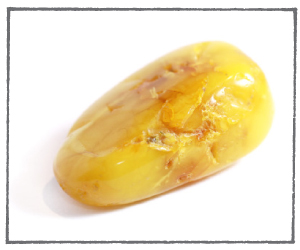AMBER

AMBER IS AN ORGANIC COMPOUND. When coniferous trees secrete resin to protect themselves from insects or injury and conditions are right, the resin can harden over hundreds of years to create copal. As it continues to fossilize over many millions of years, copal eventually hardens into amber. The oldest specimens are more than 320 million years old, and pieces of amber used as beads and carvings date back to the Stone Age. Gem historians believe that amber may have been one of the very first stones used by humans as a talisman and as jewelry. Amber pieces that contain plant matter are not uncommon, but insects and even animals such as lizards can also be found in it. The latter are exceedingly rare, but highly fascinating, as resin has captured everything from tree frogs to seeds in its warm embrace. While the majority of amber has always been found in the Baltic regions, the stone is also mined from sedimentary deposits in ancient and often buried forests in the Dominican Republic and South America and is still washed ashore by the tempestuous seas of Northern Europe.
Folklore about amber is rich and full of magic. Greek mythology tells of Phaethon, son of the sun god Helios, who rode his father’s chariot too close to Earth, setting the world ablaze. To save humanity and the land itself, Zeus struck the boy with a bolt of lightning, and he fell to his death into the River Eridanus. Mourning their brother’s death, his sisters vowed to stay with his body for all time. Eventually the girls’ bodies turned into trees, and their tears warmed by the sun created amber. Though many stories of the origins of amber are tragedies of Shakespearean proportions, the folklore surrounding amber’s powers are full of hope.
Amber continues to be used in jewelry and carvings today. Most examples are yellow, orange, or red. A heat-treated green variety also exists, and rare blue specimens (the color is caused by fluorescence) are highly prized. Naturally occurring examples containing leaves, insects, and other fossils are highly collectable and are most often found in private and museum collections.
Throughout history, amber has been considered a vessel of eternal youth, a symbol of eternal bonds, and an amulet against evil spirits, and it has been worn to enhance fertility and healing. It is believed to symbolize the zodiac sign Leo.